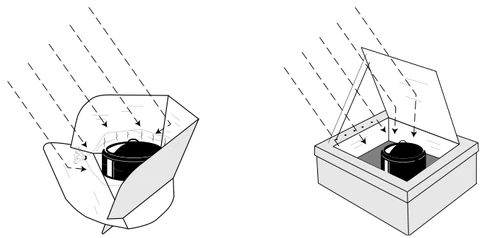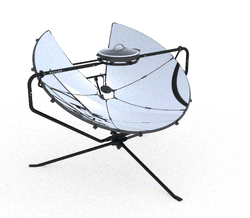Paul Hedrick (talk | contribs) |
Tom Sponheim (talk | contribs) mNo edit summary |
||
| (3 intermediate revisions by 2 users not shown) | |||
| Line 5: | Line 5: | ||
<td valign="top" width="45%">__TOC__</td> |
<td valign="top" width="45%">__TOC__</td> |
||
<td valign="top" width="55%" style="padding:9px;"> |
<td valign="top" width="55%" style="padding:9px;"> |
||
| − | Below you will find information about how solar cookers work. The Solar Cooking Wiki also provides an individual page for [[:Category:Countries|{{CountryCount}} different countries]] where you will find news, NGOs, manufacturers, and individuals working on solar cooking projects in that country. Links to possible funders are also available: |
+ | Below you will find information about how solar cookers work. The Solar Cooking Wiki, sponsored by [http://solarcookers.org Solar Cookers International], also provides an individual page for [[:Category:Countries|{{CountryCount}} different countries]] where you will find news, NGOs, manufacturers, and individuals working on solar cooking projects in that country. Links to possible funders are also available: |
<imagemap>Image:Country2.png| |
<imagemap>Image:Country2.png| |
||
| Line 15: | Line 15: | ||
Most solar cookers work on the basic principle: Sunlight warms pots and/or food, which is used for cooking. |
Most solar cookers work on the basic principle: Sunlight warms pots and/or food, which is used for cooking. |
||
| + | ===How do dark colored cook pots get hot?=== |
||
| − | ===Understanding color theory=== |
||
Light waves are absorbed by dark colors. We see the color white because virtually all of the light waves across the color spectrum are reflected away from the surface of the material. All colors together create white. However, we see true black because all the light waves are being absorbed into the material, and nothing is being reflected away. |
Light waves are absorbed by dark colors. We see the color white because virtually all of the light waves across the color spectrum are reflected away from the surface of the material. All colors together create white. However, we see true black because all the light waves are being absorbed into the material, and nothing is being reflected away. |
||
| − | This absorbed light photon energy |
+ | This absorbed light photon energy excites molecules making up the dark colored cook pot. Excited molecules have more kinetic energy, which we measure as temperature. The dark colored [[Solar cooking pots|cook pot]] heats up. |
With a [[solar box cooker]], some of the sunlight is reflected back out of the cooker from the non-dark colored surfaces through the glass enclosure. However heat radiation from the cook pot has a longer wavelength than most visible light, and can not escape back through the glass, contributing to overall higher temperatures within the cooking chamber. The insulated walls of the cooker also help in retaining the heat generated from the dark colored cook pot. |
With a [[solar box cooker]], some of the sunlight is reflected back out of the cooker from the non-dark colored surfaces through the glass enclosure. However heat radiation from the cook pot has a longer wavelength than most visible light, and can not escape back through the glass, contributing to overall higher temperatures within the cooking chamber. The insulated walls of the cooker also help in retaining the heat generated from the dark colored cook pot. |
||
| − | Below, is more on the basic science for [[solar panel cookers]] and [[solar box cooker]]s. Another style of solar cooker is a [[parabolic solar cooker]]. They typically require more frequent reorientation to the sun, but will cook more quickly at higher temperatures as they can focus more sunlight on the cook pot, enabling them to be able to fry foods. [[Evacuated tube solar cooker designs|Evacuated tube solar cookers]] use a highly insulated double-wall glass tube for the cooking chamber, and do not require large reflectors as they rely on |
+ | Below, is more on the basic science for [[solar panel cookers]] and [[solar box cooker]]s. Another style of solar cooker is a [[parabolic solar cooker]]. They typically require more frequent reorientation to the sun, but will cook more quickly at higher temperatures as they can focus more sunlight on the cook pot, enabling them to be able to fry foods. [[Evacuated tube solar cooker designs|Evacuated tube solar cookers]] use a highly insulated double-wall glass tube for the cooking chamber, and do not require large reflectors as they rely on their ability to retain high levels of heat. |
<table style="width:100%"> |
<table style="width:100%"> |
||
| Line 50: | Line 50: | ||
[[File:Industrial_scale_cooking,_Solare_Brucke,_6-10-15.png|thumb|300px|[[Institutional solar cooking]] can employ many large [[parabolic solar cooker|parabolic]] reflectors to generate steam, and cook for thousands of people daily. Many of these systems are in use in [[India]]. This example, was built with technology from [[Solare Brücke]].]] |
[[File:Industrial_scale_cooking,_Solare_Brucke,_6-10-15.png|thumb|300px|[[Institutional solar cooking]] can employ many large [[parabolic solar cooker|parabolic]] reflectors to generate steam, and cook for thousands of people daily. Many of these systems are in use in [[India]]. This example, was built with technology from [[Solare Brücke]].]] |
||
{{clr}} |
{{clr}} |
||
| + | |||
===Converting sunlight to heat energy=== |
===Converting sunlight to heat energy=== |
||
At its simplest, the sunlight-to-heat conversion occurs when photons (particles of light) moving around within light waves interact with molecules moving around in a substance. The rays emitted by the sun have a lot of energy in them. When they strike matter, whether solid or liquid, all of this energy causes the molecules in that matter to vibrate. [[Principles_of_Solar_Box_Cooker_Design#Heat_gain|This activity generates heat]]. |
At its simplest, the sunlight-to-heat conversion occurs when photons (particles of light) moving around within light waves interact with molecules moving around in a substance. The rays emitted by the sun have a lot of energy in them. When they strike matter, whether solid or liquid, all of this energy causes the molecules in that matter to vibrate. [[Principles_of_Solar_Box_Cooker_Design#Heat_gain|This activity generates heat]]. |
||
Revision as of 19:26, 19 June 2020
|
Last edited: 9 June 2020
|
|
Below you will find information about how solar cookers work. The Solar Cooking Wiki, sponsored by Solar Cookers International, also provides an individual page for 143 different countries where you will find news, NGOs, manufacturers, and individuals working on solar cooking projects in that country. Links to possible funders are also available: |
How do solar cookers work?
Most solar cookers work on the basic principle: Sunlight warms pots and/or food, which is used for cooking.
How do dark colored cook pots get hot?
Light waves are absorbed by dark colors. We see the color white because virtually all of the light waves across the color spectrum are reflected away from the surface of the material. All colors together create white. However, we see true black because all the light waves are being absorbed into the material, and nothing is being reflected away.
This absorbed light photon energy excites molecules making up the dark colored cook pot. Excited molecules have more kinetic energy, which we measure as temperature. The dark colored cook pot heats up.
With a solar box cooker, some of the sunlight is reflected back out of the cooker from the non-dark colored surfaces through the glass enclosure. However heat radiation from the cook pot has a longer wavelength than most visible light, and can not escape back through the glass, contributing to overall higher temperatures within the cooking chamber. The insulated walls of the cooker also help in retaining the heat generated from the dark colored cook pot.
Below, is more on the basic science for solar panel cookers and solar box cookers. Another style of solar cooker is a parabolic solar cooker. They typically require more frequent reorientation to the sun, but will cook more quickly at higher temperatures as they can focus more sunlight on the cook pot, enabling them to be able to fry foods. Evacuated tube solar cookers use a highly insulated double-wall glass tube for the cooking chamber, and do not require large reflectors as they rely on their ability to retain high levels of heat.
- Parabolic solar cookers use a bowl-shaped reflector to focus the light more directly onto the cookpot, usually from below, and typically do not require a greenhouse enclosure to retain the heat. They can also fry and broil foods.

SolSource is an example of a parabolic solar cooker shown with cookware. The light is focused at the bottom of the cookpot.
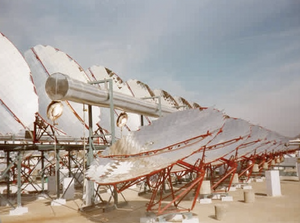
Institutional solar cooking can employ many large parabolic reflectors to generate steam, and cook for thousands of people daily. Many of these systems are in use in India. This example, was built with technology from Solare Brücke.
Converting sunlight to heat energy
At its simplest, the sunlight-to-heat conversion occurs when photons (particles of light) moving around within light waves interact with molecules moving around in a substance. The rays emitted by the sun have a lot of energy in them. When they strike matter, whether solid or liquid, all of this energy causes the molecules in that matter to vibrate. This activity generates heat.
Dark surfaces get very hot in sunlight, whereas light surfaces don't. While food cooks best in dark, shallow, thin metal pots with dark, tight-fitting lids, there are many other containers that can also be used in a solar cooker.
- Main article: Pots
Retaining heat
A transparent heat trap around the dark pot lets in the sunlight, and keeps the heat that is produced from escaping. This is a clear, heat-resistant plastic bag or large inverted glass bowl (in panel cookers) or an insulated box with a glass or plastic window (in box cookers).
Light passes through the plastic bag or glass cover as a relatively short wavelength. Heat is reflected back as a longer wavelength, and does not easily pass back through the clear enclosure. This explains why cars left in the sun, especially those with black interiors, will slowly become hotter and hotter, even on days with low air temperatures.
Parabolic solar cookers typically do not require a heat trap, as the light from the reflector is tightly focused on the cook pot. They cook at higher temperatures, but require more frequent reorientation with the sun than box or panel cookers.
- Main article: Glazing
Capturing extra sunlight energy
One or more shiny surfaces reflect extra sunlight onto the pot, increasing its heat potential. Mirrors, aluminum foil, Mylar, mirror-finish metals, chrome sign vinyl, and other shiny materials have all been used successfully for solar cooking, depending on the type of cooker and the environment in which it will be used.
- Main article: Reflective material
Solar cooker types
The three most common types of solar cookers are box cookers, curved concentrators (parabolics) and panel cookers. Hundreds — if not thousands — of variations on these basic types exist. Additionally, several large-scale solar cooking systems have been developed to meet the needs of institutions worldwide.
Box cookers
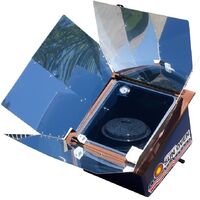
Box cookers cook food at moderate to high temperatures and often accommodate multiple pots, typically taking between one and three hours to cook various foods. Worldwide, they are the most widespread. There are several hundred thousand in India alone.
- Main article: Solar box cooker designs
Panel cookers
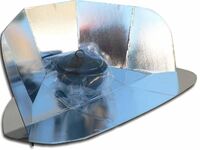
Panel cookers incorporate elements of box and parabolic concentrator cookers. They are simple and relatively inexpensive to buy or produce. Solar Cookers International's "CooKit" is the most widely used combination cooker.
- Main article: Solar panel cooker designs
Parabolic cookers
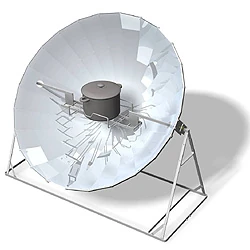
The AlSol 1.4 parabolic cooker demonstrates how the cook pot is supported to receive the focused light from below from the reflector.
Parabolic solar cookers use a bowl shaped reflector to focus the light more directly onto the cook pot, usually from below, and typically do not require a greenhouse enclosure to retain the heat. The parabolic name refers to the shape of the curve of the reflector cross-section.
They will require more frequent reorientation to the sun, possibly every 10 minutes, but they cook food more quickly at higher temperatures compared to other solar cookers, often reaching over 200°C (400°F). They also have the ability to fry foods. Generally parabolic solar cookers will need to be attended to more than box or panel cookers to avoid possibly burning the food at the bottom of the cook pot. They are especially useful for large-scale institutional cooking.
- Main article: Parabolic solar cooker designs
Evacuated tube solar cooker designs
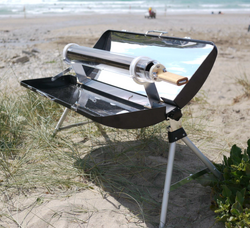
The SLiCK SM70 is an example of an evacuated tube solar cooker.
Evacuated tube solar cookers use a double-wall glass tube for the cooking chamber. The space between the glass is created as a vacuum, providing excellent heat retention. While efficient, glass technology somewhat limits the size of opening of the glass tube, requiring smaller cooking pots.
- Main article: Evacuated tube solar cooker designs
See Also
- Sunlight
- Principles of Solar Box Cooker Design - Mark Aalfs
- The Technology of Solar Cooking - Ed Pejack
- All solar cooker designs found on this wiki
- Introduction to solar cooking
- Why solar cook
- Where solar cook
- Health and safety
- Solar water pasteurization
- Solar calculations
- July 2006: Varieties of Solar Cooker Devices and Uses - Shyam Nandwani
External links
- Parabola-Focus-Directrix: interactive parabolic curve calculator- Jose Antonio Gutierrez Guerra
- Construction of Solar Cookers and Driers - Christelle Souriau & David Amelin (This is an excellent overview of solar cooking basics and simple solar cooker and dryer construction methods.)
- Parabolic Solar Cookers - Humboldt State University
- How Solar Cooking Works - HowStuffWorks
- The full text of the book The Expanding World of Solar Box Cooking - Barbara Kerr
- Evaluation of Several Original and Commonly Used Solar Cooker Designs - Dane Dormio and Steven Jones
- Rating Solar Cookers
- French: Evaluation des fours solaires




